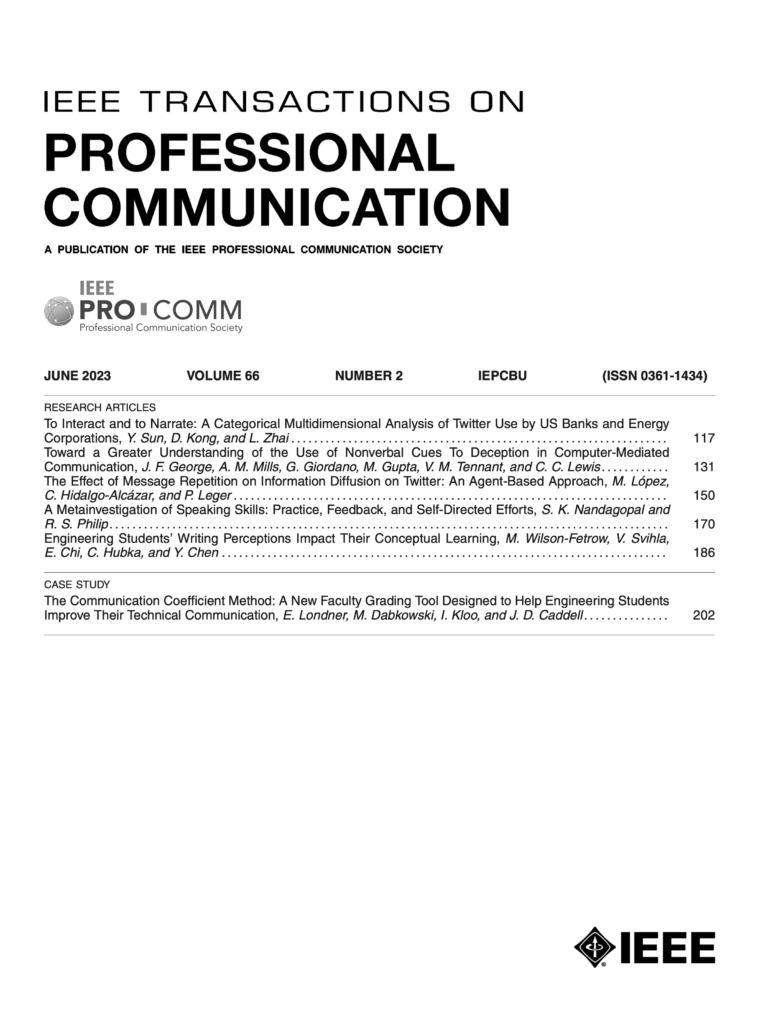The June 2023 issue of IEEE Transactions on Professional Communication is Now Available
Published on June 10, 2023
Volume 66, Number 2, June 2023

RESEARCH ARTICLES
To Interact and to Narrate: A Categorical Multi-Dimensional Analysis of Twitter Use by US Banks and Energy Corporations, Y. Sun, D. Kong, and L. Zhai
This study used summary language variables of Linguistic Inquiry and Word Count (LIWC) as dimensions of register variation, and also conducted categorical multidimensional analysis (CMDA) of linguistic features and features specific to Twitter. Results showed that tweets of both industries tend to display a categorical, confident self-regulating style, and a mixed tone. Tweets of banks are more formal, self-regulating, and oriented toward narrative, while tweets of energy corporations are more authentic and oriented toward interaction. Overall, this study strengthens the idea that corporations use Twitter to facilitate corporate communication with a broadcasting strategy and narrative perspective, and to improve digital communication with an engaging strategy. Findings may shed light on promoting products and corporate impression management on social media.
Towards a Greater Understanding of the Use of Nonverbal Cues to Deception in Computer-Mediated Communication, J. George, A. M. Mills, G. Giordano, M. Gupta, V. M. Tennant, and C. C. Lewis
Computer-mediated communication is an important part of work life but can be dishonest, and when people attempt to judge dishonesty, they tend to rely on a few nonverbal cues that are not the most reliable. We conducted an experiment with 132 veracity judges from New Zealand and Jamaica, who observed interview segments in Spanish and Hindi (languages that they did not understand) to isolate the effects of nonverbal cues. They determined the veracity of each segment and listed the things that guided their judgment. The results suggest that when certain nonverbal cues are available, such as gaze aversion, these suppress attention to more reliable cues (e.g., voice pitch) when judging deception. Redirecting attention to more reliable cues is therefore important. Unexpectedly, cue choice also varied across language by medium. The findings extend the understanding of people’s use of nonverbal cues and the extent to which certain cues distract in the deception judgment.
The Effect of Message Repetition on Information Diffusion on Twitter: An Agent-Based Approach, M. López, C. Hidalgo-Alcázar, and P. Leger
Twitter offers tools that facilitate the diffusion of information by which companies can engage consumers to share their messages. Communication professionals are using platforms such as Twitter to disseminate information; however, the strategies that they should use to achieve high information diffusion are not clear. This article proposes message repetition as a strategy. An agent-based simulation model for information diffusion is proposed as an approach to measure the diffusion of a tweet that has been repeated. The model considers that consumers can reach their wear-out point when they read a tweet several times. The results of the model indicate the number of times a company should send the same tweet to achieve high information diffusion before this action has negative effects on consumers.
A Meta-Investigation of Speaking Skills: Practice, Feedback and Self-Directed Efforts, S. K. Nandagopal and R. S. Philip
This article documents a speaking assessment carried out among 120 engineering students who opted for the English for Competitive Exams elective course to improve their English language proficiency. Students were trained on speaking skills as part of this semester-long online course, and an assessment for speaking skills was designed in which students answered 10 self-reflective questions about their perception and the usefulness of practice, feedback from the instructor and peers, and self-directed efforts. Each student’s recorded audio file was part of the assessment. A qualitative and interpretative investigation of their answers reflected on their learning experiences during the semester, and their self-ratings were analyzed thematically. We conclude that using practice, feedback, and self-directed efforts with a culminating phase of oral self-reflection is highly beneficial in developing speaking skills in engineering courses focusing on technical communication.
Engineering Students’ Writing Perceptions Impact Their Conceptual Learning, M. Wilson-Fetrow, V. Svihla, E. Chi, C. Hubka, and Y. Chen
We conducted a design-based research study in three semesters of an upper division chemical engineering laboratory course to study the use of feedback, revision, and reflection, and to develop contextualized theory about the relationships between these and students’ conceptual learning. Students’ writing was analyzed qualitatively. We found that students who elaborated on errors and corrections scored significantly lower on conceptual understanding in their final submission, while students who described writing as an ongoing process scored significantly higher on conceptual understanding in their final reports. We found a similar trend for students who completed a second cycle, and especially that a focus on perfecting a written artifact corresponded to lesser gains. Our findings lend support for assisting engineering students to approach writing as a developmental and learning process and for engaging them in multiple rounds of feedback, revision, and reflection across their programs of study.
CASE STUDY
The Communication Coefficient Method: A New Faculty Grading Tool Designed to Help Engineering Students Improve Their Technical Communication, E. Londner, M. Dabkowski, I. Kloo, and J. D. CaddellThis article examines the communication coefficient (CC), a new method for grading student technical communication intended to encourage students to treat their communication with the same importance that it has in the professional workplace. The core philosophy of the CC method is that audiences perceive technical work more positively when it is communicated well. The method captures this philosophy mathematically: students’ grades result from multiplying the points earned for technical content by a number—the coefficient—representing how well they communicated that content. The CC method is rooted in established principles, such as holistic grading and the separate yet simultaneous consideration of content and communication. The CC method was found to encourage better student communication, although mixed student and instructor opinion suggest that changes to the method and the way that it is messaged are necessary.

